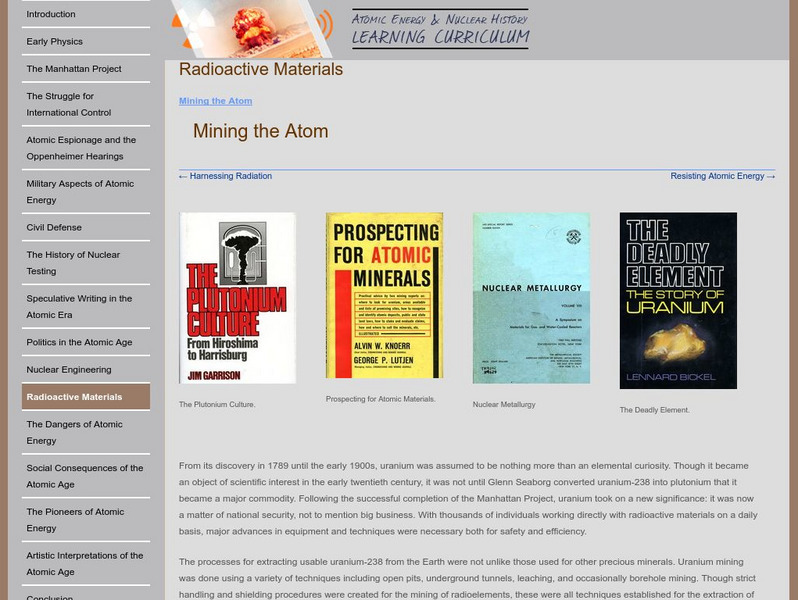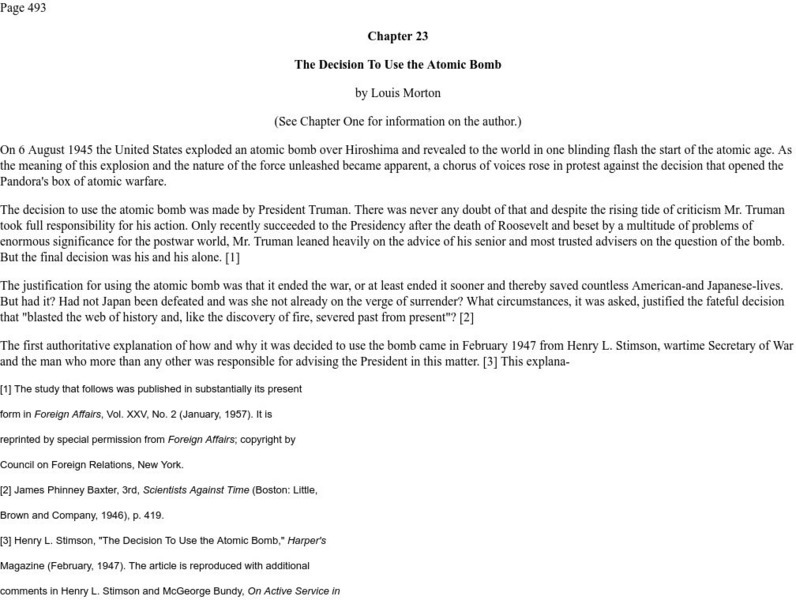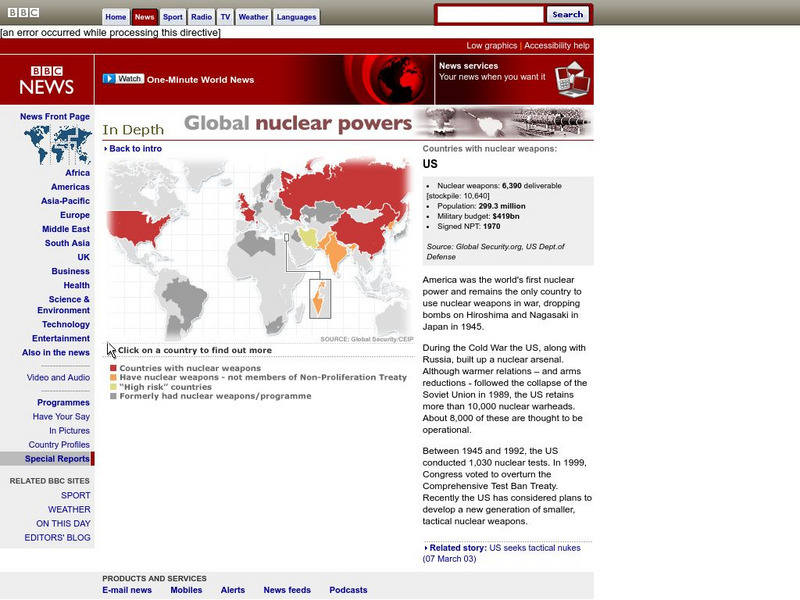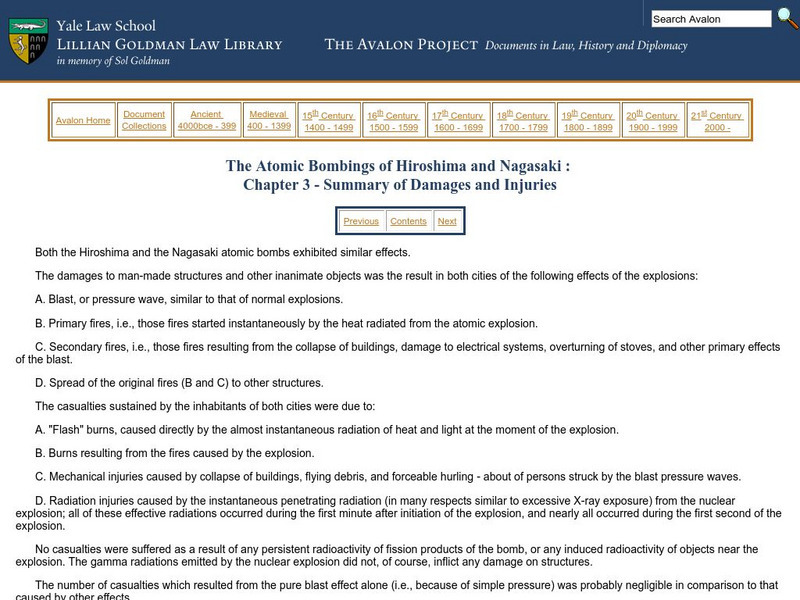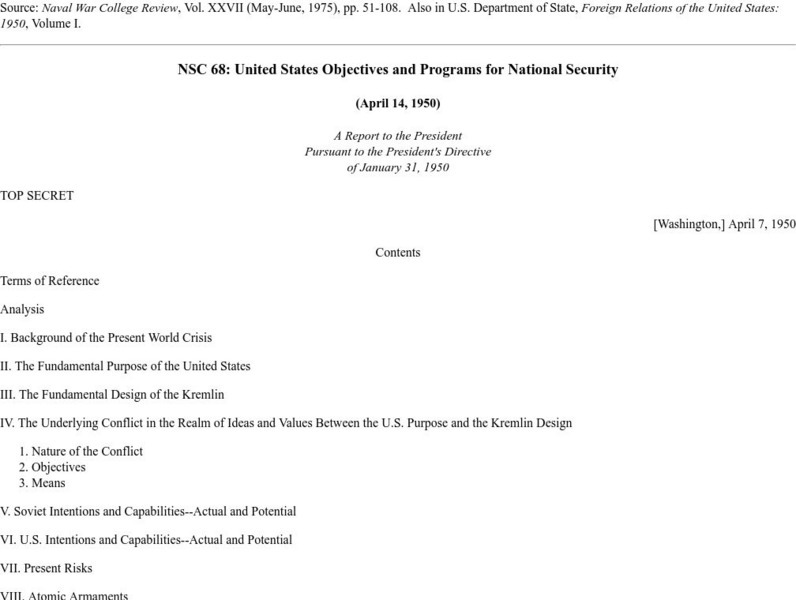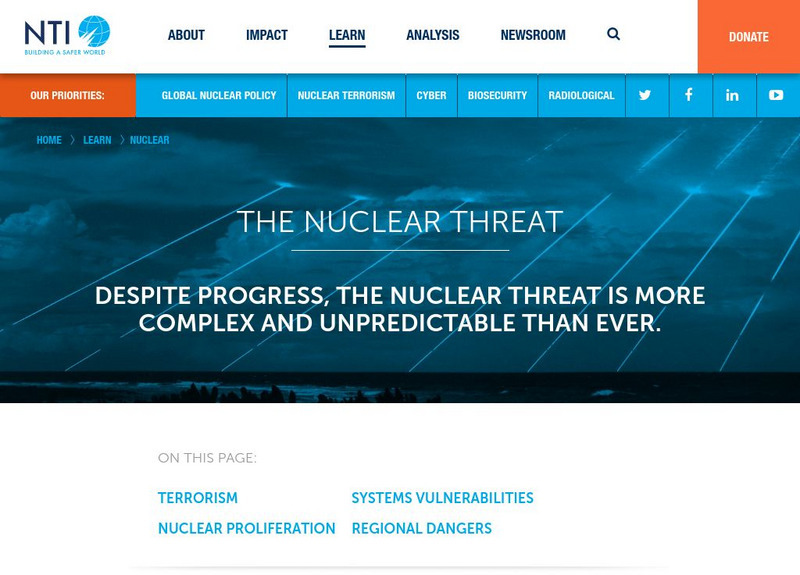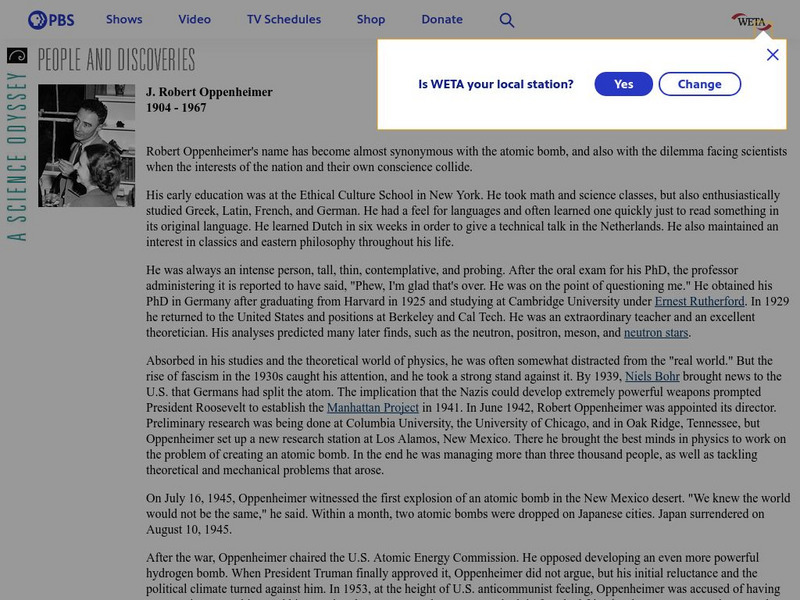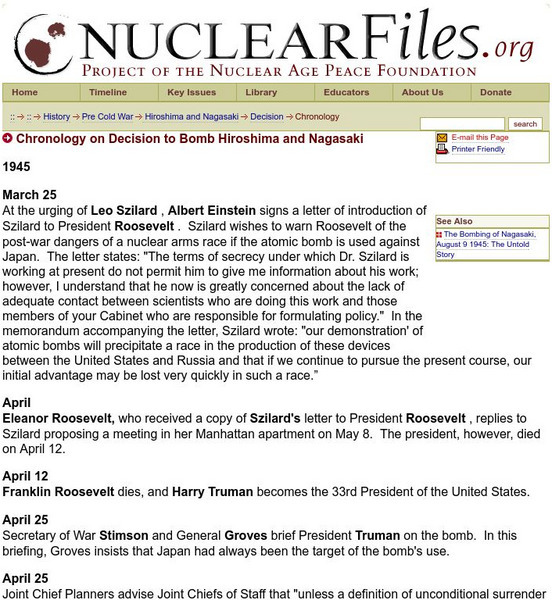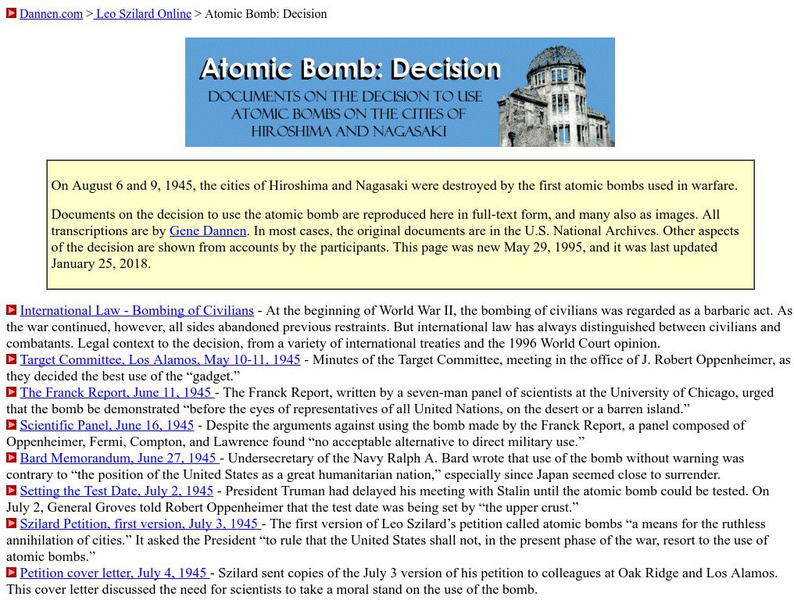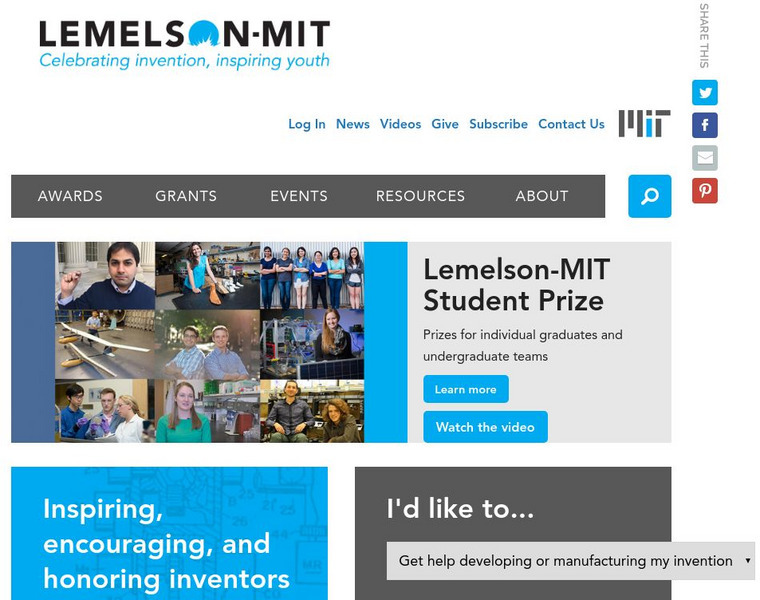Curated OER
The Consequences of World War II
Ninth graders explore the aftermath of World War II. In this World War II lesson, 9th graders investigate the consequences of the war as they complete a post-assessment project that requires them to compose essays on the topic.
Curated OER
World War II
Learners examine the events of World War II that led to the dropping of the atomic bomb on Japan. Creating a decision making tree, they weigh the positives and negatives of the decision to use the bomb. They participate in a class...
Oregon State University
Oregon State University: Radioactive Materials: Mining the Atom
Online exhibit from Oregon State University on radioactive materials.
PBS
Pbs American Experience: Race for the Superbomb
This site explores the Cold War race to develop the hydrogen bomb, a weapon that would change the world. Content details all the people who were involved in the race for the H-Bomb, as well as notable events during this time period....
CBS
Cbs News: Nuclear Armed World
An evaluation of countries in the world that possess nuclear weapons and weapons of mass destruction. Examines missile defense programs. Includes a timeline showing the growth of nuclear weapons in the world.
US Army Center
U.s. Army Center of Military History: The Decision to Use the Atomic Bomb
In-depth analysis of the decision to create and drop the atomic bomb on Japan during World War II. Includes details on the Interim Committee.
BBC
Bbc: Global Nuclear Powers
An interactive map which shows every country that has nuclear weapons, has programs to gain nuclear weapons, had nuclear weapon programs, or is suspected of having a nuclear weapon.
Flow of History
Flow of History: Nuclear Arms Race
The events and countries involved in the nuclear arms race are profiled. Text plus a colored graphic flowchart make the topic visually appealing and of interest to both students and educators.
Other
Nevada Test Site Oral History Project
A comprehensive look at the 50 years of nuclear testing in Nevada through oral histories of the participants. In addition to the histories, the site includes a timeline, information about the test sites, and videos.
Yale University
Summary of Damages and Injuries
Outlines the devastation the atomic bomb had on Hiroshima and Nagasaki, Japan.
Mount Holyoke College
International Relations: Nsc 68: United States Objectives for National Security
Primary source document of the National Security Council Document 68. (NSC-68)
PBS
Pbs News Hour Extra: Controlling Nuclear Weapons
For this lesson plan, students examine the impact of weapons of mass destruction, e.g., the atomic bombs dropped on Japan in World War II. They look at nuclear proliferation and treaties, and debate the pros and cons of nuclear weapons.
Other
Nuclear Threat Initiative: The Nuclear Threat
Discusses countries and the weapons of mass destruction they possess. Includes interactives features.
Ohio State University
Osu History Teaching Institute: The Manhattan Project
Students will discuss the role of technology of the atomic bomb and explore the destruction of Nagasaki and Hiroshima during WWII. Students will then outline some of the social and political changes that resulted from the Manhattan Project.
Wikimedia
Wikipedia: Mutual Assured Destruction
A complete description of the concept of Mutual Assured Destruction. Explains what the concept means, and how the concept was used during the Cold War and up to the George W. Bush Administration. Includes links to terms that may require...
PBS
Pbs: J. Robert Oppenheimer 1904 1967
This site from PBS provides biographical information about J. Robert Oppenheimer, and his involvement with the atomic bomb.
Other
Nuclearfiles.org: Chronology on Decision to Bomb
This detailed chronology of the events and communication of 1945-1946 shows Truman's role in the process of the decision to drop the world's first atomic bomb used in warfare upon Hiroshima and then the second upon Nagasaki. Also...
Other
Nuclearfiles.org: 20 Mishaps and Possible Nuclear War
Read summaries of 20 accidents that moved the United States and USSR dangerously close to "mutually assured destruction" and nuclear war during the Cold War. A chilling reminder of the constant threat faced by all during that period of...
New York Times
New York Times: Truths of the Second Nuclear Age
Identifies how many warheads different countries have throughout the world. Also provides information about the United States' and Russia's current arsenals. Discusses which countries have signed the non-proliferation treaties and which...
Other
Atomic Bomb: Decision
An indexing page which links to several pages of letters, diary excerpts, public reports, and personal correspondence relating to the use of the first atomic bomb. Includes letters and petitions drafted by scientists involved with the...
Science Struck
Science Struck: Atomic Bomb Facts
Discusses lost nuclear weapons, the power of an atomic bomb, the bombing of Hiroshima and Nagasaki, the development of the atomic bomb, the making of the hydrogen bomb, the detonation of a hydrogen bomb by Russia in 1961, and the status...
Organization for Community Networks
Academy Curricular Exchange: Post Nuclear War Survival
Gives the students an idea that sometimes there is not a correct answer especially when dealing with nuclear war. Students discuss possible outcomes of a nuclear exchange.
US Energy Information Administration
U.s. Eia Energy Kids: Timelines: Nuclear Energy
Timeline of key events in the development of nuclear energy and nuclear weapons, including early scientific discoveries related to atomic science.
Massachusetts Institute of Technology
Mit: Inventor of the Week: J. Robert Oppenheimer
Credited with the creation of the atomic bomb, Robert Oppenheimer opposed the development of the hydrogen bomb. Read about Oppenheimer's education and involvement in the atomic explosions, which "changed the world forever."




